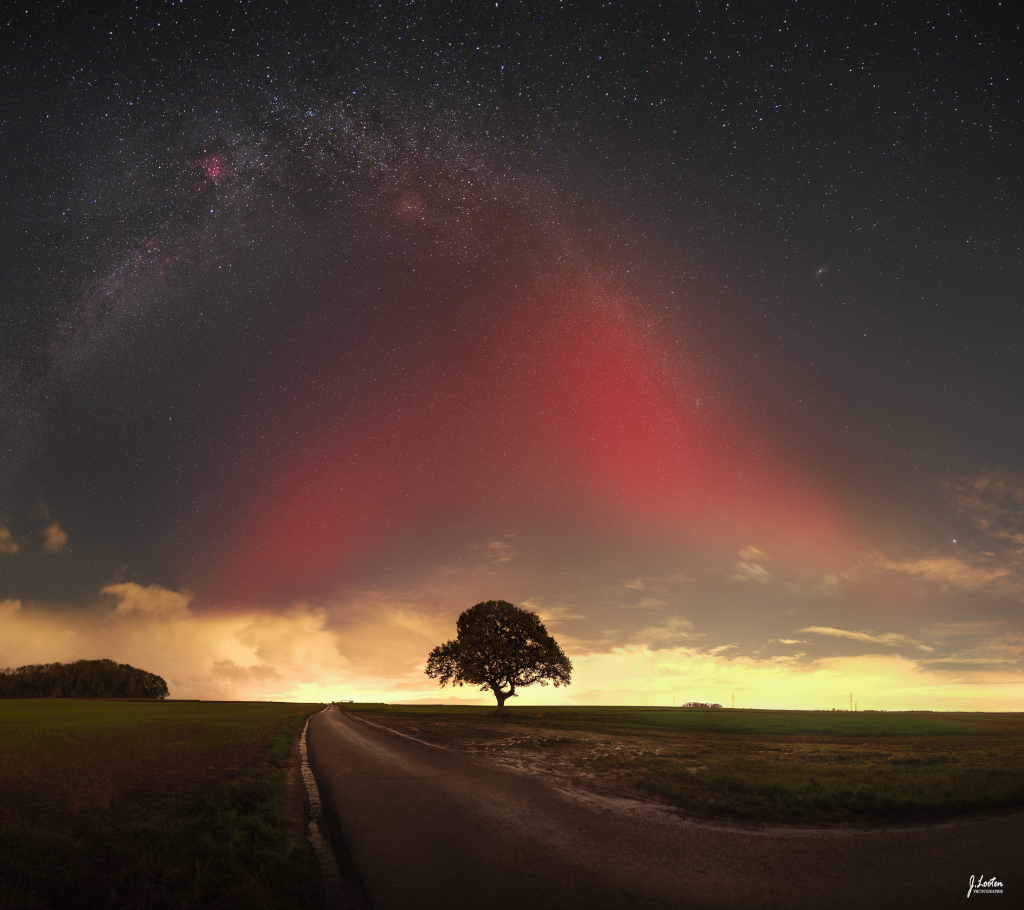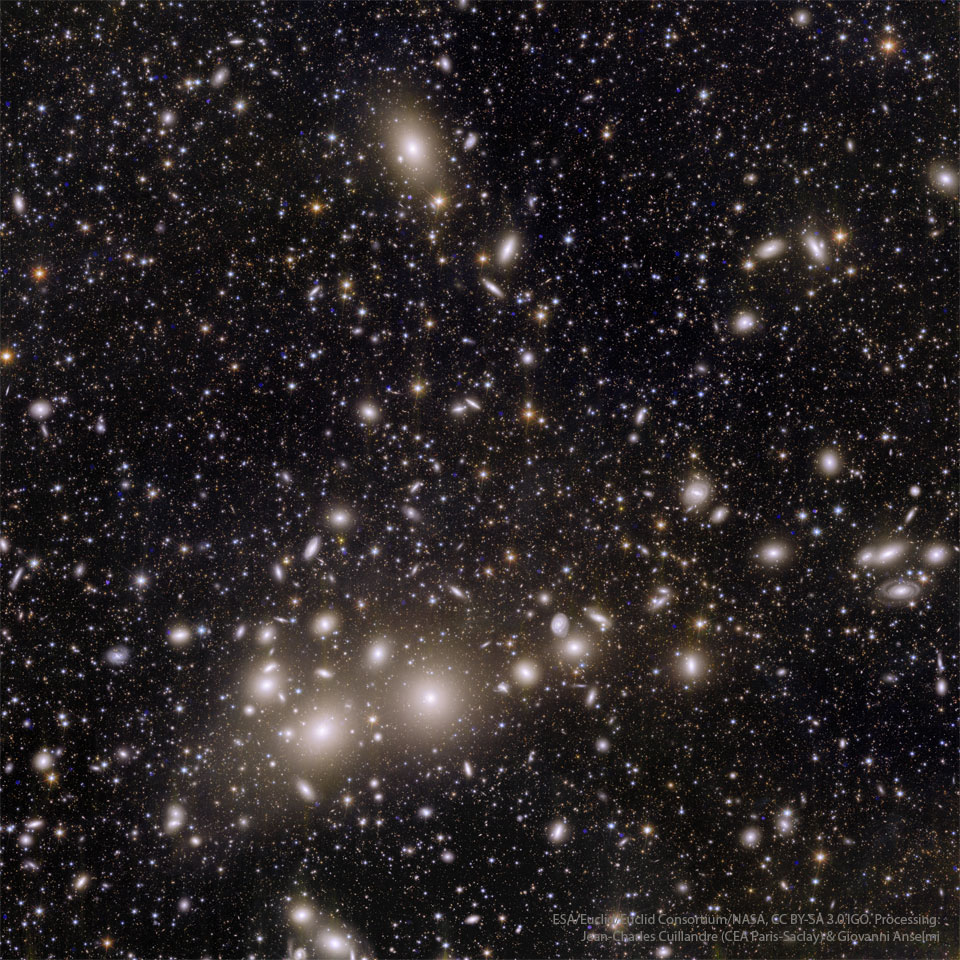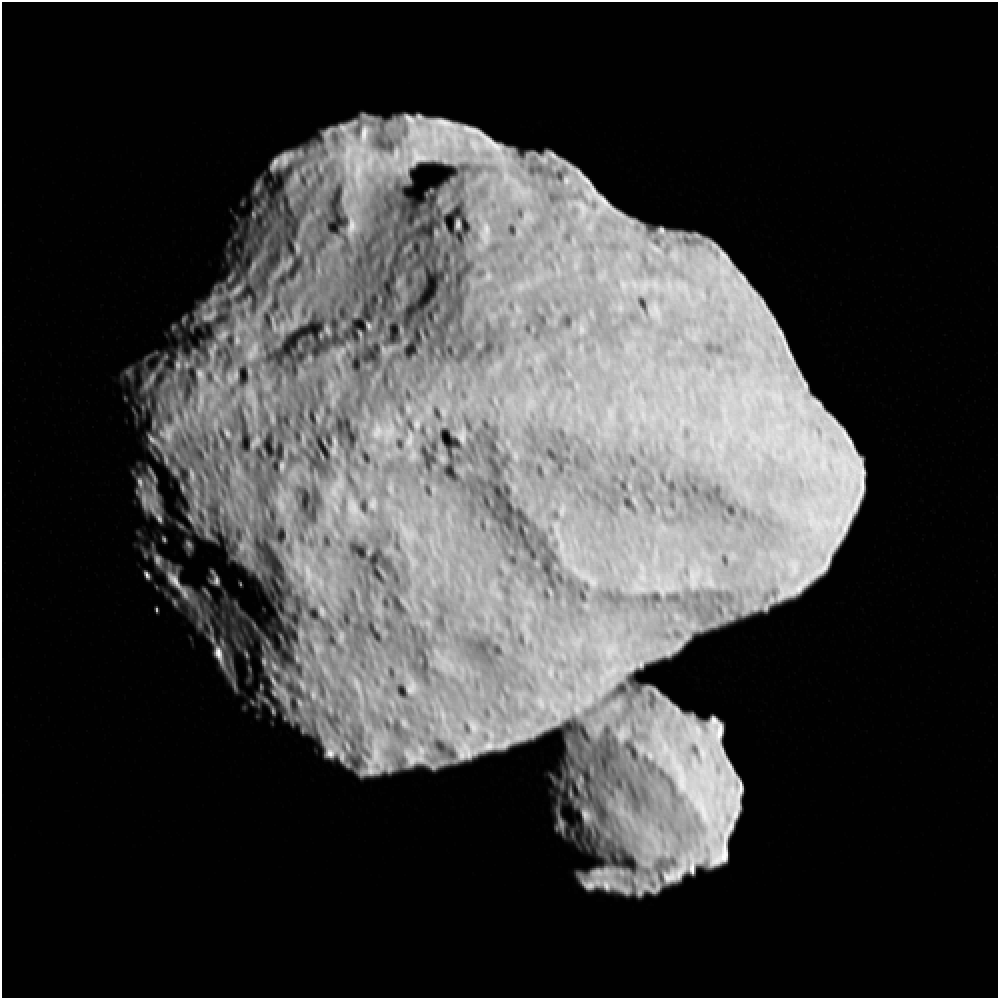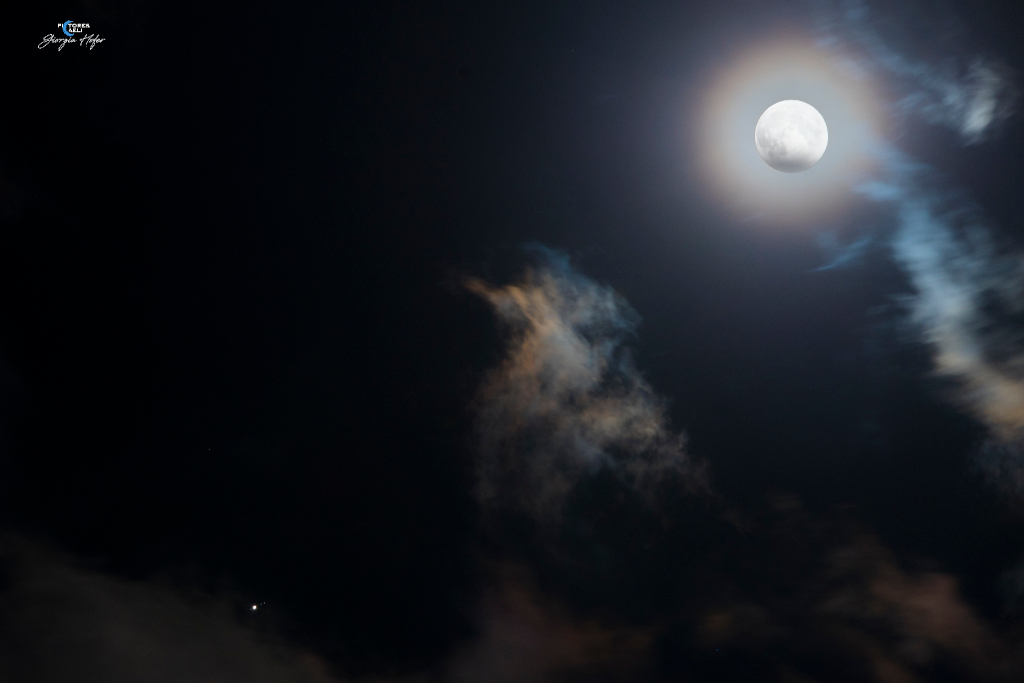
Nombre total de pages vues
11/11/2023
SANTé/MEDECINE - Gros seins

ASTRONOMY - The SAR and the Milky Way
2023 November 11
Explanation: This broad, luminous red arc was a surprising visitor to partly cloudy evening skies over northern France. Captured extending toward the zenith in a west-to-east mosaic of images from November 5, the faint atmospheric ribbon of light is an example of a Stable Auroral Red (SAR) arc. The rare night sky phenomenon was also spotted at unusually low latitudes around world, along with more dynamic auroral displays during an intense geomagnetic storm. SAR arcs and their relation to auroral emission have been explored by citizen science and satellite investigations. From altitudes substantially above the normal auroral glow, the deep red SAR emission is thought to be caused by strong heating due to currents flowing in planet Earth's inner magnetosphere. Beyond this SAR, the Milky Way arcs above the cloud banks along the horizon, a regular visitor to night skies over northern France.
09/11/2023
ASTRONOMY - M1: The Crab Nebula
2023 November 9
Image Credit: NASA, ESA, CSA, STScI; Tea Temim (Princeton University)
Explanation: The Crab Nebula is cataloged as M1, the first object on Charles Messier's famous 18th century list of things which are not comets. In fact, the Crab is now known to be a supernova remnant, debris from the death explosion of a massive star witnessed by astronomers in the year 1054. This sharp image from the James Webb Space Telescope’s NIRCam (Near-Infrared Camera) and MIRI (Mid-Infrared Instrument) explores the eerie glow and fragmented strands of the still expanding cloud of interstellar debris in infrared light. One of the most exotic objects known to modern astronomers, the Crab Pulsar, a neutron star spinning 30 times a second, is visible as a bright spot near the nebula's center. Like a cosmic dynamo, this collapsed remnant of the stellar core powers the Crab's emission across the electromagnetic spectrum. Spanning about 12 light-years, the Crab Nebula is a mere 6,500 light-years away in the head-strong constellation
08/11/2023
ASTRONOMY - Perseus Galaxy Cluster from Euclid
2023 November 8
Image Credit & License: ESA, Euclid, Euclid Consortium, NASA; Processing: Jean-Charles Cuillandre (CEA Paris-Saclay) & Giovanni Anselmi; Text: Jean-Charles Cuillandre
Explanation: There's a new space telescope in the sky: Euclid. Equipped with two large panoramic cameras, Euclid captures light from the visible to the near-infrared. It took five hours of observing for Euclid's 1.2-meter diameter primary mirror to capture, through its sharp optics, the 1000+ galaxies in the Perseus cluster, which lies 250 million light years away. More than 100,000 galaxies are visible in the background, some as far away as 10 billion light years. The revolutionary nature of Euclid lies in the combination of its wide field of view (twice the area of the full moon), its high angular resolution (thanks to its 620 Megapixel camera), and its infrared vision, which captures both images and spectra. Euclid's initial surveys, covering a third of the sky and recording over 2 billion galaxies, will enable a study of how dark matter and dark energy have shaped our universe.
07/11/2023
ASTRONOMY - A Martian Dust Devil Spins By
2023 November 7
Video Credit: NASA, JPL-Caltech, Perseverance Rover; AI processing: PipploIMP
Explanation: It moved across the surface of Mars -- what was it? A dust devil. Such spinning columns of rising air are heated by the warm surface and are also common in warm and dry areas on planet Earth. Typically lasting only a few minutes, dust devils become visible as they pick up loose red-colored dust, leaving the darker and heavier sand beneath intact. Dust devils not only look cool -- they can leave visible trails, and have been credited with unexpected cleanings of the surfaces of solar panels. The images in the featured AI-interpolated video were captured in early August by the Perseverance rover currently searching for signs of ancient life in Jezero Crater. The six-second time-lapse video encapsulates a real duration of just over one minute. Visible in the distance, the spinning dust devil was estimated to be passing by at about 20 kilometers per hour and extend up about 2 kilometers high.
06/11/2023
ASTRONOMY - Creature Aurora Over Norway
2023 November 5
Image Credit & Copyright: Ole C. Salomonsen (Arctic Light Photo)
Explanation: It was Halloween and the sky looked like a creature. Exactly which creature, the astrophotographer was unsure (but possibly you can suggest one). Exactly what caused this eerie apparition in 2013 was sure: one of the best auroral displays that year. This spectacular aurora had an unusually high degree of detail. Pictured here, the vivid green and purple auroral colors are caused by high atmospheric oxygen and nitrogen reacting to a burst of incoming electrons. Birch trees in Tromsø, Norway formed an also eerie foreground. Frequently, new photogenic auroras accompany new geomagnetic storms.
ASTRONOMY - Red Aurora over Italy
2023 November 6
Image Credit & Copyright: Giorgia Hofer
Explanation: What was that red glow on the horizon last night? Aurora. Our unusually active Sun produced a surface explosion a few days ago that sent out a burst of electrons, protons, and more massive charged nuclei. This coronal mass ejection (CME) triggered auroras here on Earth that are being reported unusually far south in Earth's northern hemisphere. For example, this was the first time that the astrophotographer captured aurora from her home country of Italy. Additionally, many images from these auroras appear quite red in color. In the featured image, the town of Comelico Superiore in the Italian Alps is visible in the foreground, with the central band of our Milky Way galaxy seen rising from the lower left. What draws the eye the most, though, is the bright red aurora on the far right. The featured image is a composite with the foreground and background images taken consecutively with the same camera and from the same location.
04/11/2023
MACROPHOTOGRAPHIE - Fougère ou flocon de neige ?

ASTRONOMY - Dinkinesh Moonrise
2023 November 4
Image Credit: NASA/Goddard, SwRI, Johns Hopkins APL, NOIRLab
Explanation: Last Wednesday the voyaging Lucy spacecraft encountered its first asteroid, 152830 Dinkinesh, and discovered the inner-main belt asteroid has a moon. From a distance of just over 400 kilometers, Lucy's Long-Range Reconnaissance Imager captured this close-up of the binary system during a flyby at 4.5 kilometer per second or around 10,000 miles per hour. A marvelous world, Dinkinesh itself is small, less than 800 meters (about 0.5 miles) across at its widest. Its satellite is seen from the spacecraft's perspective to emerge from behind the primary asteroid. The asteroid moon is estimated to be only about 220 meters wide.
03/11/2023
ASTRONOMY - Jupiter by Moonlight
2023 November 3
Image Credit & Copyright: Giorgia Hofer
Explanation: That bright beacon you've seen rising in the east just after sunset is Jupiter. Climbing high in midnight skies, our Solar System's ruling gas giant was at its 2023 opposition, opposite the Sun in planet Earth's sky, on November 2. But only a few days earlier, on October 28, the Moon was at its own opposition. Then both Full Moon and Jupiter could share this telephoto field of view. The celestial scene is composed from two exposures, one long and one short, blended to record bright planet and even brighter Moon during that evening's partial lunar eclipse. Moonlight shining through the thin, high clouds over northern Italy creates the colorful iridescence and lunar corona. Look closely and you'll also spot some of Jupiter's Galilean moons.
ASTRONOMY - Andromeda and Sprites over Australia
2025 December 16 Andromeda and Sprites over Australia Image Credit & Copyright: JJ Rao Explanation: What’s happening over that tree? ...
-
2022 September 26 All the Water on Planet Earth Illustration Credit: Jack Cook, Adam Nieman, Woods Hole Oceanographic Institution ; Data ...
-
2025 May 11 The Surface of Venus from Venera 14 Image Credit: Soviet Planetary Exploration Program , Venera 14 ; Processing & Copyri...






